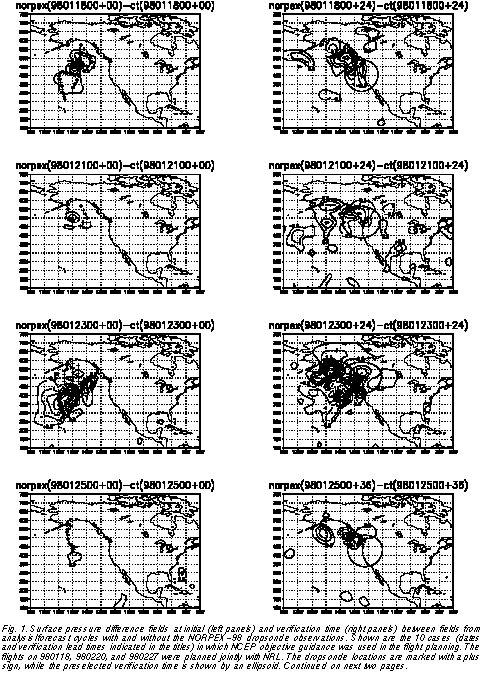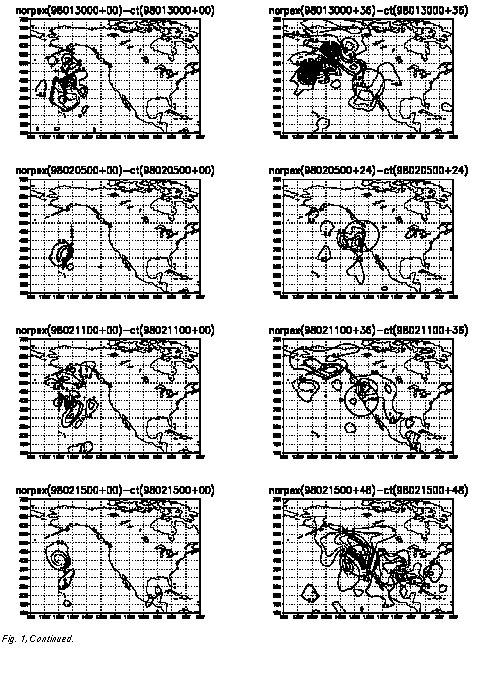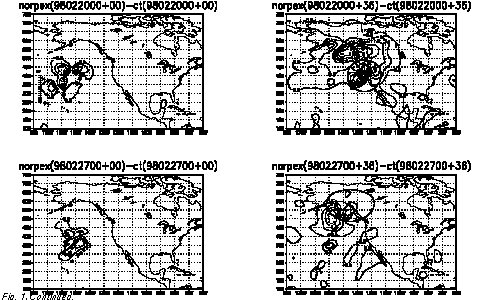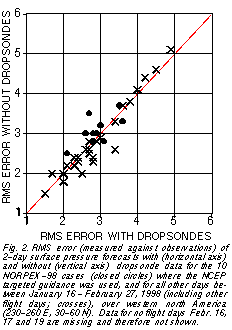 ENSEMBLE-BASED TARGETED OBSERVATIONS DURING NORPEX
ENSEMBLE-BASED TARGETED OBSERVATIONS DURING NORPEX ENSEMBLE-BASED TARGETED OBSERVATIONS DURING NORPEX
ENSEMBLE-BASED TARGETED OBSERVATIONS DURING NORPEX Istvan Szunyogh1, Zoltan Toth2, Sharan Majumdar3, Rebecca Morss4, Craig Bishop3, and Steven Lord
Environmental Modeling Center, NCEP, NWS/NOAA, Washington DC 20233
1. INTRODUCTION
Between January 16 and February 27, 1998, a multi-agency field experiment, NORPEX-98, took place over the northeastern Pacific (Langland et al., 1998). The field experiment was designed and carried out jointly by the Environmental Modeling Center of NCEP/NWS/NOAA (with assistance from PSU and MIT) and the Naval Research Laboratory of the US Navy. The primary purposes of the experiments were (1) to test adaptive observing strategies by collecting data in areas most sensitive to forecast errors developing downstream over the US, and (2) by using such data, to impove 1-3 days operational numerical weather predictions, that serve the basis for most weather forecasts and warnings.
2. THE FIELD EXPERIMENTS
During the experiments, 38 research flights were carried out with the G-lV NOAA aircraft operated by the NOAA Flight Facilities, and by two US Air Force Reserve C-130 planes. From these flights, close to 700 dropsondes were released measuring atmospheric conditions over the northeastern Pacific, an area otherwise void of traditional observations. The research flights were planned so that data could be collected adaptively from "sensitive" areas with the greatest promise for improving 1-3 days forecasts over the US. Two objective methods were used during NORPEX for determining the most sensitive observational areas. NCEP used the ensemble transform (ET) technique (Bishop and Toth, 1998), developed jointly with PSU, which is based on the use of operationally available ensemble forecasts, while NRL used adjoint sensitivity analysis, based on the use of linear tangent and adjoint models.
The targeted dropsonde data were used in real time by NCEP, FNMOC and other numerical weather prediction centers worldwide. In addition, high-resolution geostationary satellite derived wind observations were also provided by CIMSS of the University of Wisconsin, in conjunction with NOAA and NESDIS, for the entire Pacific ocean basin every 6 hours during the field experiments.
3. APPLICATION OF TARGETED OBSERVATIONS
For operationally successful adaptive observation
missions the following issues have to be considered:
· Case selection - For determining if extra data
can substantially improve the forecasts
· Sensitivity analysis - For identifying the area from
where data can have the greatest impact
· Flight planning - For laying out a pattern of
dropsonde locations for optimum impact
· Data analysis - For insuring the data are used
to its full advantage.
4. EVALUATION RESULTS
Because of the complex nature of the decision making process, if possible, both the individual components and the overall results of targeted observations need to be analyzed. The evaluation of the effectiveness of the two sensitivity calculation methods, i. e. the ET and adjoint techniques used at NCEP and NRL respectively, is in progress. In the rest of the paper we present an evaluation of the ten NORPEX cases in which the NCEP strategy was used (in three of these cases, along with NRL guidance).
4.1 Ensemble Transform sensitivity
The sensitivity calculations should ideally point to an
area from where the forecast impact of the adaptively taken data at a preselected future verification time and place
could be the largest among any areas. Since data can be
collected only over relatively small areas, this hypothesis
cannot be tested directly. However, we found that (1) The
maximum of the average impact of the dropsonde data
(difference between forecasts initiated from analysis
cycles with and without the dropsonde data) is at the same
gridpoint where the averaged center of verification regions
is for the ten NCEP cases. (2) The maximum of the signal
reaches the preselected verification region at verification
time (see Fig. 1

 ). In the two cases (1998011800 and
1998013000) where the maximum signal is outside the
verification region, additional sensitivity calculations confirm that the largest impact is expected outside the verification region. (3) The amplification of the signal introduced
by the data correlates with the amplification in the ensembles used in the ET technique.
). In the two cases (1998011800 and
1998013000) where the maximum signal is outside the
verification region, additional sensitivity calculations confirm that the largest impact is expected outside the verification region. (3) The amplification of the signal introduced
by the data correlates with the amplification in the ensembles used in the ET technique.
4.2 Forecast improvement
In the evaluation of the ten NCEP cases, different measures of forecast skill were used, such as forecast precipitation amount, surface pressure, and wind rms error. Overall, 70-90% of the 6-120 hours forecasts showed a clear improvement when the adaptively taken dropsonde data were also assimilated. In several cases the forecast error was reduced by as much as 60% in the most critical areas where the forecasts were intended to be improved.
In order to compare the forecast performance of the
ten cases with forecasts originated on other days during
NORPEX, in Fig. 2 we show the rms error of 2-day surface
pressure forecasts over a western north American region.
In 7 out of the 10 cases the forecasts originating from the
analysis cycle that used the dropsonde data had a positive
impact, in 2 cases there was a degradation, while one case
was inconclusive. The positive data impact is statisitically
significant at the 10% level. In addition, the 10 cases show
more positive data impact than seen either on all other
days during the experiments or on other flight days (differences are statistically significant at the 5% level).
we show the rms error of 2-day surface
pressure forecasts over a western north American region.
In 7 out of the 10 cases the forecasts originating from the
analysis cycle that used the dropsonde data had a positive
impact, in 2 cases there was a degradation, while one case
was inconclusive. The positive data impact is statisitically
significant at the 10% level. In addition, the 10 cases show
more positive data impact than seen either on all other
days during the experiments or on other flight days (differences are statistically significant at the 5% level).
4.3 Case selection
An important finding of our study is that the amplification of ensemble perturbations from the targeted region into the verification region is a good indicator whether the adaptive data improve the forecasts or not. In most cases where the ensemble perturbations amplify the data impact is positive, while in those cases where the ensemble perturbations decay, the forecast impact is mixed.
4.4 Other field experiments
During March 1998, the same ET technique used in NORPEX was also applied in the CALJET field experiments (Ralph et al., 1998), except now adjusted for mesoscale forecast features in the 12-24 hours time range (instead of synoptic scale features in the 1-3 days time range during NORPEX). All objective targeted missions were successful in a sense that the adaptively taken data impacted the desired forecast features. We also note that all the major findings of this paper are supported by results based on the use of the ET technique during the FASTEX field experiments (Szunyogh et al., 1998).
5. DISCUSSION
The positive experience accumulated in the course of adaptive observational work in three field experiments (FASTEX, NORPEX and CALJET) holds a promise for a relatively quick transition of targeting technology from the research environment into operational practice. The targeting technology can then be used, depending on the expected socio-economic benefits, with any existing or new components of the observing network that can be operated adaptively. The scientifically most critical aspect of targeting, the sensitivity calculations (ensemble transform technique at NCEP) have been thoroughly tested in field experiments. Before a full operational implementation, the other aspects of targeting, case selection, and flight planning, will also need to be formalized and automated.
Bishop, C. H., Z. Toth, 1998: Ensemble transformation and adaptive observations. J. Atmos. Sci., under review.
Langland, R., Z. Toth, R. Gelaro, I. Szunyogh, M. Shapiro, S. Majumdar, R. Morss, G. D. Rohaly, C. Velden, N. Bond, C. Bishop, 1998: The north Pacific experiments (NORPEX-98): Targeted observations for improved north American weather forecasts. To be submitted to BAMS.
Ralph, M. O. Persson, D. Reynolds, P. Neiman, W. Nuss, J. Schmidt, D. Jorgensen, C. King, A. White, J. Bao, W. Neff, D. Kingsmill, D. Miller, Z. Toth, and J. Wilczak, 1998: The use of tropospheric profiling in the California land-falling jets experiment (CALJET). Proceedings of the 4th International Symposium on Tropospheric profiling: Needs and Technologies, 20-25 September 1998, Snowmass, CO, in press.
Szunyogh, I., Z. Toth, K. A. Emanuel, C. Bishop, J. Woolen, T. Marchok, R. Morss, and C. Snyder, 1998: Ensemble-based targeting experiments during FASTEX: The impact of dropsonde data from the LEAR jet. QJRMS, under review.
2. GSC (Laurel, MD) at NCEP. Corresponding author address: Z. Toth, NCEP/EMC, 5200 Auth Rd., Room 207, Camp Springs, MD 20746. Zoltan.Toth@noaa.gov